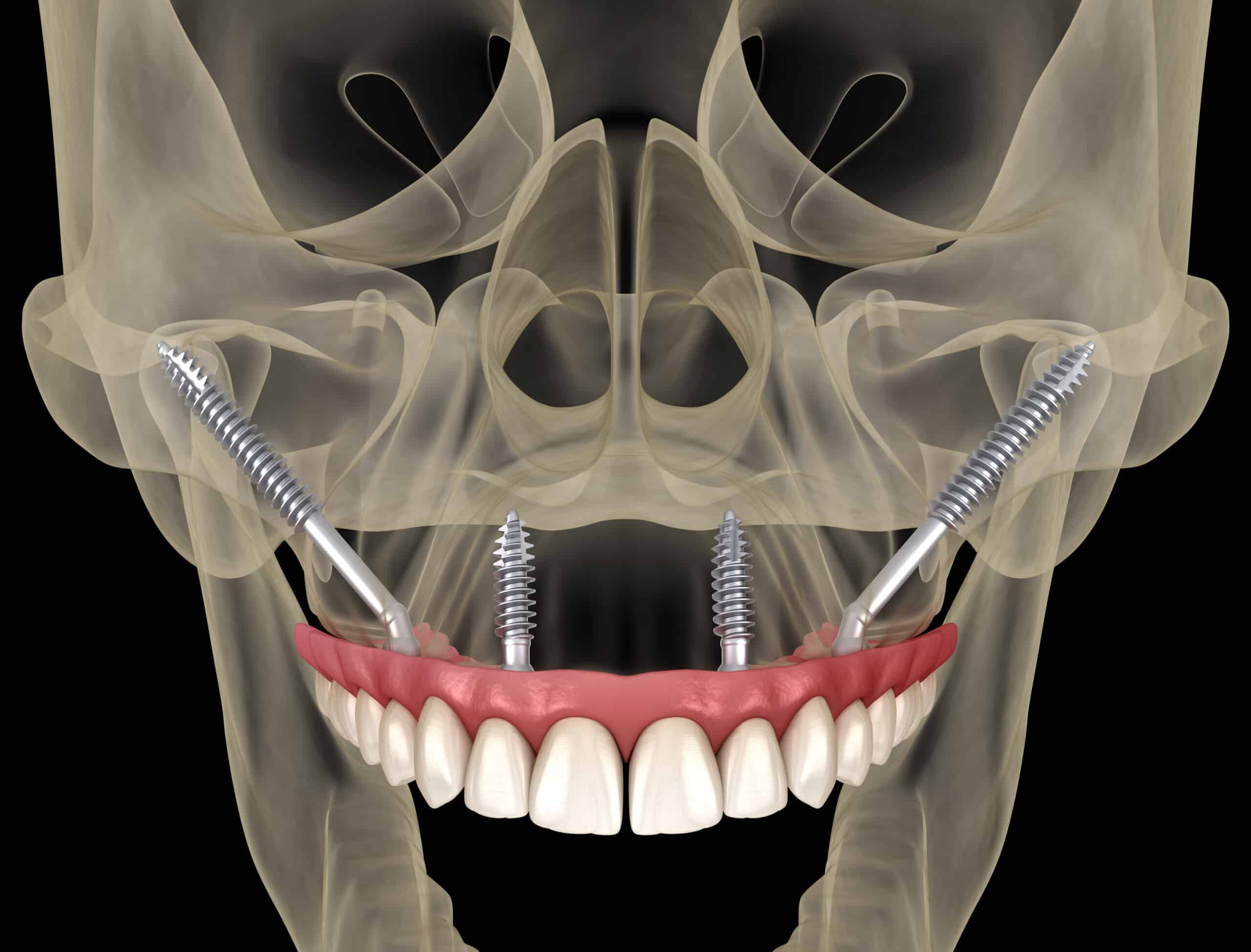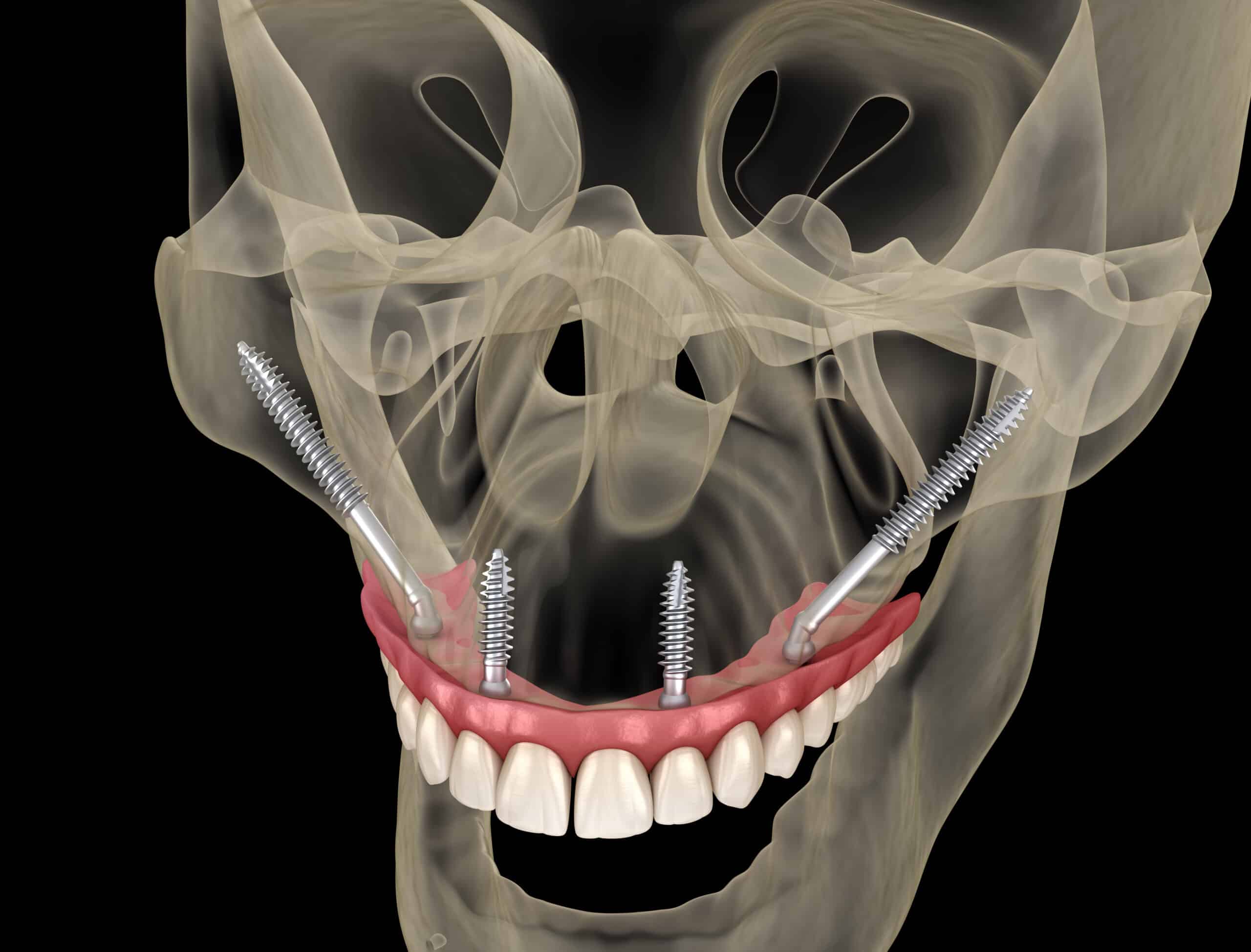In the face of tooth loss, one of the treatments that offers the greatest long-term advantages in terms of functionality and esthetics are dental implants.
These screws, which are inserted inside the jawbone, replace the root of the tooth, providing a correct fastening of the prosthesis, whether it is a crown or a complete rehabilitation.
However, one of the disadvantages when placing implants is the lack of dental bone or the fact of not having enough of it.
For this type of patient, it is possible to opt for zygomatic implants, whose characteristics make it possible to place prostheses despite the lack of bone mass.
However, zygomatic implants -or zygomatic implants- entail a series of problems that we explain below.
For this reason, at DrAW Dental Clinic we do not place these implants and, instead, we offer alternatives for patients with little bone.
What is a zygomatic implant?
A zygomatic implant works in exactly the same way as a regular implant: it replaces the tooth root and serves as a support for a prosthesis.
This allows the patient to chew normally and restore the esthetics of his or her smile.
However, they are implants that are only used in certain cases, specifically when the person does not have enough bone to hold the screw.
The second difference with respect to other implants is found in its appearance: it is several centimeters longer.
Zygomatic implant
Enlarge image
ZYGOMATIC IMPLANT
When is a zygomatic implant used?
People who are missing a dental piece and do not replace it with a prosthesis, end up experiencing a loss of dental bone.
This process occurs because the alveolus stops receiving stimulus from the periapical root.
At this point, it is not possible to insert an implant in the maxillary bone, since part of the body of the screw would remain in the air, endangering its survival.
Zygomatic dental implants receive their name because, unlike those most commonly used in dentistry, they are inserted in the zygomatic bone.
This is why this type of implant must be longer than conventional implants.
While the latter do not exceed 1 centimeter, zygomatic implants can measure between 5 and 6 centimeters.
And the fact is that, unlike the others, they must reach a bone structure farther away from the teeth.
The use of zygomatic implants is very rare due to the risks of surgery and subsequent complications.
The paranasal sinuses and the zygomatic bone
To better understand the anatomy and structure of the face, it is important to differentiate the paranasal sinuses and the location of the zygomatic bone.
The paranasal sinuses are a set of cavities that communicate with the nasal cavities and play an important role in daily activities such as breathing and phonation.
They are located in the bones of the face and skull and each person has 8 sinuses, distributed in 4 groups on each side of the face.
They are called frontal, ethmoidal, maxillary and sphenoidal sinuses.
The zygomatic bone, also known as the malar bone, is the structure located in the outermost part of the face, which is usually identified with the cheekbone.
Zygomatic implants: complications
Zygomatic implants, due to their characteristics and location, entail a series of problems during their placement and with regard to the dental prosthesis.
We find complications in zygomatic implants in several issues:
- Technique to place them
- Location of the implant
- Greater complexity in the rehabilitation
Technique of zygomatic implants
First of all, the technique for inserting them implies a greater risk and more difficulty.
Due to its length, the implant is very close to the eye, so the professional who inserts it must be an experienced maxillofacial surgeon.
In addition, the postoperative period for the patient is usually slightly longer than if a conventional implant is inserted.
Look for different options
Thanks to advances in dental implants, it is possible to recover all your teeth even if you do not have enough bone.
Poor support for the implant
Due to the location of the zygomatic implant, it has little support and can cause a greater number of problems over time.
Keep in mind that it must pass through the maxillary sinus (which is an empty cavity) to reach the zygomatic bone.
Therefore, most of the body of the implant remains in the air, that is, inside the sinus but without a surface to rest on.
The end of the implant that is inserted in the zygomatic bone barely reaches 10 millimeters.
Zygomatic implants technique
Enlarge image
POSITION OF THE IMPLANT
Dental rehabilitations
The maxillofacial surgeon does not normally perform the subsequent rehabilitation process, i.e. the fitting of dental prostheses.
Therefore, the next phase of the treatment must be performed by another implantology specialist.
Due to the length of the implant and the fact that it must reach the zygomatic bone, it is placed in a diagonal position.
When fitting the prosthesis, it often has to adapt to this unusual position for an implant.
Therefore, it occupies a larger surface in the mouth, taking space away from the palate and tongue.
WE ARE SPECIALISTS IN IMPLANTS
What alternatives do I have to get an implant without bone?
For all that we have explained, at DrAW Dental Clinic we do not work with this type of dental implants, as it implies more risks for the patient.
Instead, we offer several options to people who need to recover their teeth but do not have enough bone.
For these cases, it is possible to opt for two alternatives, depending on your requirements and needs.
Bone grafting
Through a bone graft it is possible to obtain a larger bone surface that ensures optimal support for the dental implant.
Therefore, in the case of a lack of quality bone, this treatment allows the placement of conventional implants.
This process is carried out thanks to an element called Bio-oss, a compound formed by hydroxyapatite and calcium.
Both substances are found in the teeth, so it does not generate any incompatibility problem.
System for implant patients
Enlarge image
BONE GRAFTING WITH BIO-OSS
Sinus lift
Secondly, there is a procedure called sinus lift through which the amount of bone available in the paranasal cavity is increased.
This procedure can only be performed in the posterior area of the upper jaw, since this is where the sinuses are located.
Thanks to the operation, the amount of bone available to insert the implant and allow a correct osseointegration is enlarged vertically.
Now that you know what a zygomatic implant is and what the possible risks are, you can choose another more reliable method to recover your teeth.
Remember that a professional in implantology will always explain to you all the possible alternatives to treat your case and thus recover your smile.



